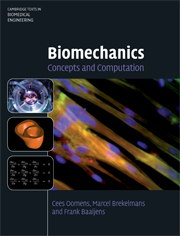Book contents
- Frontmatter
- Contents
- About the cover
- Preface
- 1 Vector calculus
- 2 The concepts of force and moment
- 3 Static equilibrium
- 4 The mechanical behaviour of fibres
- 5 Fibres: time-dependent behaviour
- 6 Analysis of a one-dimensional continuous elastic medium
- 7 Biological materials and continuum mechanics
- 8 Stress in three-dimensional continuous media
- 9 Motion: the time as an extra dimension
- 10 Deformation and rotation, deformation rate and spin
- 11 Local balance of mass, momentum and energy
- 12 Constitutive modelling of solids and fluids
- 13 Solution strategies for solid and fluid mechanics problems
- 14 Solution of the one-dimensional diffusion equation by means of the Finite Element Method
- 15 Solution of the one-dimensional convection-diffusion equation by means of the Finite Element Method
- 16 Solution of the three-dimensional convection-diffusion equation by means of the Finite Element Method
- 17 Shape functions and numerical integration
- 18 Infinitesimal strain elasticity problems
- References
- Index
17 - Shape functions and numerical integration
Published online by Cambridge University Press: 05 June 2012
- Frontmatter
- Contents
- About the cover
- Preface
- 1 Vector calculus
- 2 The concepts of force and moment
- 3 Static equilibrium
- 4 The mechanical behaviour of fibres
- 5 Fibres: time-dependent behaviour
- 6 Analysis of a one-dimensional continuous elastic medium
- 7 Biological materials and continuum mechanics
- 8 Stress in three-dimensional continuous media
- 9 Motion: the time as an extra dimension
- 10 Deformation and rotation, deformation rate and spin
- 11 Local balance of mass, momentum and energy
- 12 Constitutive modelling of solids and fluids
- 13 Solution strategies for solid and fluid mechanics problems
- 14 Solution of the one-dimensional diffusion equation by means of the Finite Element Method
- 15 Solution of the one-dimensional convection-diffusion equation by means of the Finite Element Method
- 16 Solution of the three-dimensional convection-diffusion equation by means of the Finite Element Method
- 17 Shape functions and numerical integration
- 18 Infinitesimal strain elasticity problems
- References
- Index
Summary
Introduction
In the previous chapter the shape functions Ni have hardly been discussed in any detail. The key purpose of this chapter is first to introduce isoparametric shape functions, and second to outline numerical integration of the integrals appearing in the element coefficient matrices and element column. Before this can be done it is useful to understand the minimum requirements to be imposed on the shape functions. The key question involved is, what conditions should at least be satisfied such that the approximate solution of the boundary value problems, dealt with in the previous chapter, generated by a finite element analysis, converges to the exact solution at mesh refinement. The answer is:
(i) The shape functions should be smooth within each element Ωe, i.e. shape functions are not allowed to be discontinuous within an element.
(ii) The shape functions should be continuous across each element boundary. This condition does not always have to be satisfied, but this is beyond the scope of the present book.
(iii) The shape functions should be complete, i.e. at element level the shape functions should enable the representation of uniform gradients of the field variable(s) to be approximated.
Conditions (i) and (ii) allow that the gradients of the shape functions show finite jumps across the element interface. However, smoothness in the element interior assures that all integrals in which gradients of the unknown function, say u, occur can be evaluated.
- Type
- Chapter
- Information
- BiomechanicsConcepts and Computation, pp. 295 - 312Publisher: Cambridge University PressPrint publication year: 2009

